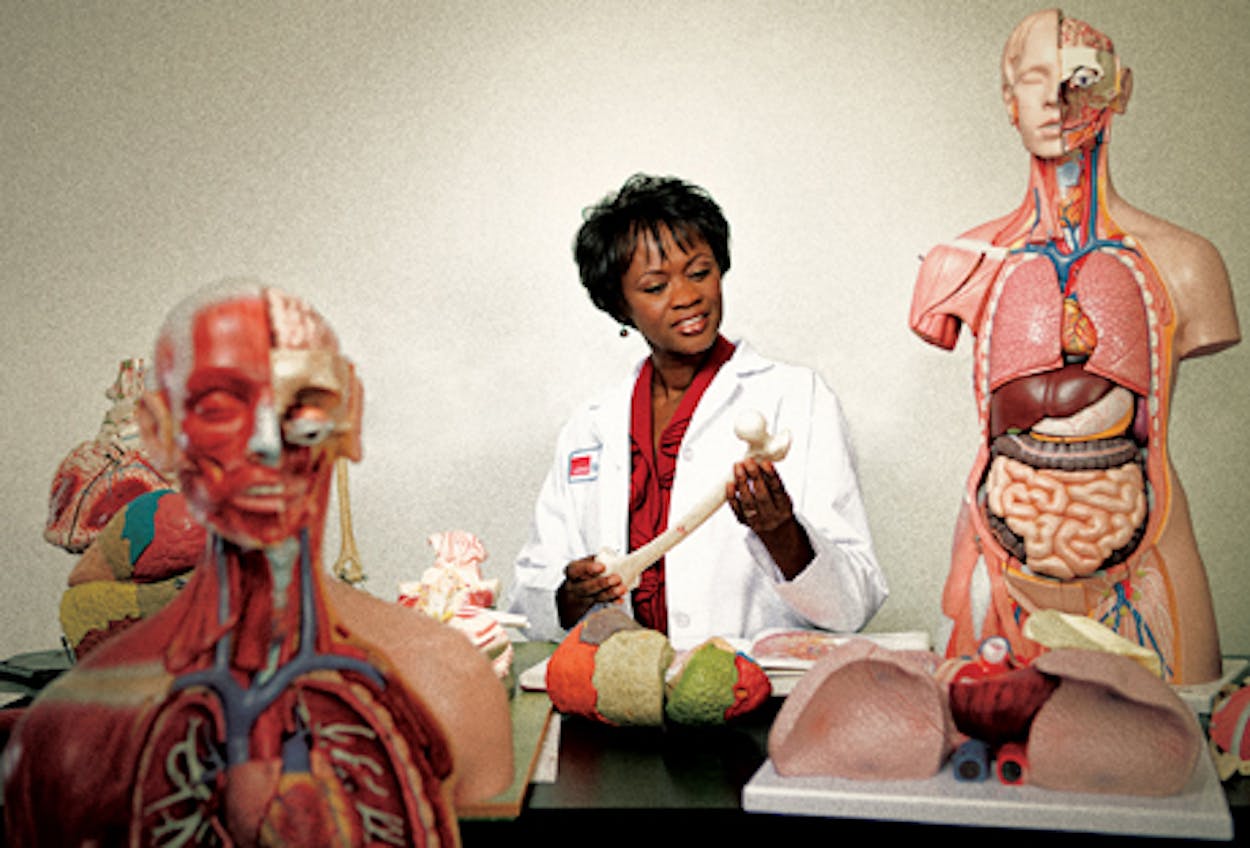Cain, whose official job title is associate professor of neuroscience and cell biology, is a Mississippi native who moved to Texas in 1992. She runs the medical school enrichment courses at the University of Texas Medical Branch at Galveston and teaches the core-curriculum course gross anatomy. When she’s not in her lab coat, Cain paints folk-art pieces that reflect her childhood in the rural South.
I’m the mother of two boys, but I have a lot of children. Since 1992 I have taught gross anatomy to every student who has entered the medical school. I am very proud of all of them.
Gross anatomy and practice of medicine are the first courses the students take. Every August, in their very first week of medical school, 230 students walk into the lab. They take gross anatomy because they have to, and some of them are nervous; they know they are going to have to really study to pass. As part of the course, they are required to dissect a human body. They want to be doctors, and one day they will have to be able to visualize what lies under a person’s skin. So for the next eight weeks, they work with cadavers—bodies that have been donated to science.
Now, this isn’t [the TV show] Grey’s Anatomy. There are no giggles. The body is not a joke. And the things they are going to do to these bodies are not a joke. I tell them that the key to getting through this, to success in medical school, is finding the right mind-set. You have to prepare yourself mentally and work hard. Personally, it doesn’t bother me, going into the gross anatomy lab. There is not a spirit in these bodies. The body is just a shell. The spirits are in another place.
I like my job. It’s busy, but I’m not afraid of hard work. I picked cotton with my grandmother in the fields in Mississippi. There’s not much that’s harder than that. But I love what I do because I get to watch the students discover that the human body is designed in the most intricate manner. When they understand how the organs are situated, they learn how everything works together. The brain, for instance, has so many compartments. Each section is responsible for different functions; all these diverse parts come together and work in such a wonderful manner. And think about a woman who is pregnant. The uterus is in the pelvis, so there is purpose to there being no separation between the pelvis and the abdominal cavity. There is no closure—it’s one continuous cavity. That gives the uterus room to grow and expand.
The students begin to discover all of this when, at the beginning of the semester, I split them into groups of eight. This is where they learn how to clinically diagnose cases. The other professors and I—there are several of us who teach anatomy—give them knowledge of the body, but in these small groups, we also monitor their professionalism. Some days the groups are given a case that includes patient history, and they have to come up with a diagnosis. This way they get to try out their clinical thinking.
The students are mapping the human body by touching and feeling. Think about a surgeon. In the ER, he or she can’t look at a picture book with an arrow that says, “Cut here and there.” You have to have it all in your mind to see it. Some people are talking these days about computers replacing the gross anatomy course, but I don’t think that would be effective. Sure, a medical student can look at a kidney on a screen, but to hold a kidney and see the shape and feel the weight—that’s more valuable.
Medicine uses visual concepts; I’ve come to appreciate that more and more as I create art in my spare time. I’ve sharpened my sense of observation by watching how students participate in a group. Everybody has to learn to prune his or her personality. Students do not have an elevated opinion of themselves; there are no God complexes yet. And if there are, they will be refined.
God is never far from my mind in the lab. I was trained in the Bible too. I am not going to debate evolution; other people can do that. And while working in science hasn’t necessarily made me closer to God—because my belief was instilled in me as a child—my work has put me more in awe of him and his creativity. The body is awesome. Think about how the muscle tendons are attached to different bones in the fingers to make them move. You don’t just bend your finger; you can point it straight, and you can bend the tip and the middle. That’s intricate and divine. That’s the work of God.
But that’s just how I feel. I simply want my students to see the wonder of the human body. After twenty years at UTMB, I know that my students’ job will be to save lives. But the first bridge they have to cross is death. They have to understand the anatomy of a dead body in order to understand life.







